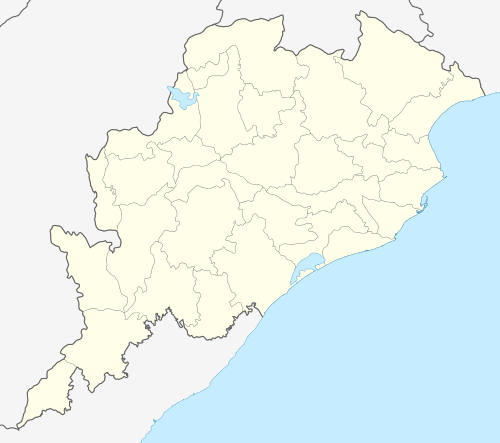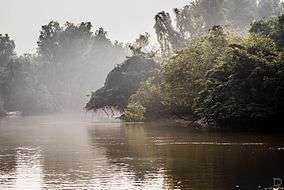Bhitarkanika National Park
| Bhitarkanika National Park | |
|---|---|
|
IUCN category II (national park) | |
|
Sunrise at Bhitarkanika National Park | |
 | |
| Location | Odisha, India |
| Nearest city | Kendrapara |
| Coordinates | 20°45′N 87°0′E / 20.750°N 87.000°ECoordinates: 20°45′N 87°0′E / 20.750°N 87.000°E |
| Area | 672 square kilometres (259 sq mi) |
| Established | 1975 |
| Governing body | Ministry of Environment and Forests, Government of India |
Bhitarkanika National Park is a national park located in the Kendrapara District Odisha in eastern India. Core area of 145 square kilometre of the Bhitarkanika Wild Sanctuary, spread over 672 km2, has been designated as a National Park since 1998.
The national park is surrounded by the Bhitarkanika Wildlife Sanctuary. Gahirmatha Beach and Marine Sanctuary lies to the east, and separates swamp region cover with canopy of mangroves from the Bay of Bengal. Thus it become a vicinity of rich biodiversity
The park is home to Saltwater Crocodile (Crocodylus porosus), White Crocodile, Indian python, King Cobra, black ibis, darters and many other species of flora and fauna.
The national park was created in September 1998 from the core area of the Bhitarkanika Wildlife Sanctuary, which was created in 1975. The sanctuary is the second largest mangrove ecosystem in India.
The national park and wildlife sanctuary is inundated by a number of rivers - Brahmani, Baitarni, Dhamra, Pathsala and others.
Flora and fauna
Flora: Mangroves, trees like sundari, thespia, casuarinas, and grasses like the indigo bush, and more.
Fauna: The park is home to the saltwater crocodile, white crocodile, Indian python, black ibis, wild pigs, rhesus monkeys, chitals, darters, cobra, water monitor lizard . Olive ridley sea-turtles nest on Gahirmatha and other nearby beaches. Bhitarkanika has one of the largest populations of endangered saltwater crocodile in India and is globally unique in that 10 percent of the adults exceed 6 m length. Nearly 1671 saltwater crocodiles inhabit the rivers and creeks.[1] Around 3,000 saltwater crocodiles were born during 2014 annual breeding and nesting season.[2]
In 2006, Guinness accepted claims of a 7.1 m (23 ft 4 in), 2,000 kg (4,400 lb) male saltwater crocodile living within Bhitarkanika National Park.[3] Due to the difficulty of trapping and measuring a very large living crocodile, the accuracy of these dimensions has yet to be verified. These observations and estimations have been made by park officials over the course of ten years, from 2006 to 2016, however, regardless of the skill of the observers it cannot be compared to a verified tape measurement, especially considering the uncertainty inherent in visual size estimation in the wild.[4] According to the park report in 2006, there were 203 adults, of which 16 measured over 4.9 m (16 ft 1 in); 5 of these 5.5 to 6.1 m (18 ft 1 in to 20 ft 0 in), and 3 over 6.1 m (20 ft 0 in), as well as the preserved skeleton of a 6.0 m (19 ft 8 in) specimen which died one year earlier.[5] A significant figure, since individuals over 5 m (16 ft 5 in) are considered rare,[6] making the Bhitarkanika Park a suitable habitat for large individuals. The most recently published official park report shows an increase of adult crocodiles to 308 individuals, as well as a steady increase over the years.[7][8] In the future, if conservation efforts pay off, these large individuals could be more common.[9]
As per the 2014 survey of mammals, first of its kind to be undertaken in the forest and wetland sites of the park; 1,872 spotted deers, 1,213 numbers of wild boars have made the forest areas their home. The census breakup of other mammals is monkeys - 1,522, jackals - 305, common langur - 39, otter - 38, sambar deer - 17, jungle cat - 11, fox - 10, Mongoose - 7, wolf- 7, fishing cats - 3, hyena - 12, according to the survey data.[10]
Avian-Fauna: 320 species of avifauna including eight varieties of Kingfishers. Birds such as Asian Open Bill, Cormorants, Darters, Black Ibis, Egrets, are frequently seen in the park. Every year close to 1,20,000 winter visitor from abroad for wintering and 80,000 resident birds from different parts of India arrive for nesting during monsoon season.[11]
Mangroves and wildlife
Mangroves are salt tolerant, complex and dynamic eco-systems that occur in tropical and subtropical inter-tidal regions. Bhitarkanika is one such location of rich, lush green vibrant eco-system lying in the estuarine region of Brahmani- Baitarani in the North-Eastern corner of Kendrapara district of Odisha. The area is intersected by a network of creeks with Bay of Bengal on the East. The alley between the meandering creeks and rivers, houses the second largest viable mangrove eco-system of India. Its 672 km². of mangrove forest & wetland, provides home to well over 215 species of birds including winter migrants from central-Asia and Europe. Giant salt water crocodiles and a variety of other wildlife inhabit this eco-system which is one of Asia's most spectacular wildlife sanctuaries.
An area of 145 km². have been notified as Bhitarkanika National Park vide Notification No.19686/F & E dated 16.9.1998 of Forests & Environment Department, Government of Odisha. It has much significance with regard to ecological, geomorphological and biological background which includes mangrove forests, rivers, creeks, estuaries, back water, accreted land and mud flats. Bhitarkanika National Park is the core area of Bhitarkanika Sanctuary.
Bhitarkanika Wildlife Sanctuary was declared vide notification No.6958/FF AH Dtd. 22.04.1975 over an area of 672 square kilometers. The Sanctuary comprising Mangrove Forests meandering rivers, innumerable criss-crossed tidal inundated creeks provide last refuge to the already endangered salt water Crocodile (Crocodile Porosus). Besides estuarine Crocodile, the Sanctuary is rich in avifauna, mammalian and reptilian population. Theses Mangrove forests are good habitat for King Cobra, Indian Python and Water Monitor Lizard. A large number of water birds visit Bagagahan heronry which is an area of approximately 4 hectare. within the Bhitarkanika Forest Block near Suajore creek from the month of June to October. Most of the Birds are Asian open bill. Egrets. Black Ibis, Cormorants, Darters & etc.
Attractions
It is a very good place to sight the giant Salt Water Crocodile, some growing to 23 feet in length, along with other reptiles like the Water Monitor Lizard and the King Cobra. Spotted deers and Wild Boars are abundant in the park and can be spotted at all the major locations. Eight varieties of Kingfishers are found here and can be spotted along the many creeks and riverines within the park.
The boat ride from Khola to Dangmal or vice versa is highly recommended. Khola is one of the gateways into the park. This is along an artificial creek and it passes through dense mangrove forest providing a glimpse into the estuarine ecosystem and its wealth of fauna. The best time to travel through this creek is early morning or before sunset.
Bhitarkanika has a very rich historical and cultural past. It used to be the hunting grounds of the erstwhile King of Kanika . The hunting towers and artificial watering holes can be seen at many places including Bhitarkanika trail and at Dangmal. It is also the home of medieval Hindu temples which can be found dotted throughout the sanctuary. But the major attraction remains the wildlife wealth.
Tourism in Bhitarkanika
Sightseeing is done on boats which have got forest department licenses. Main entrance to the forest is from Khola Gate, even though there is another gate called Gupti gate also. Tourism was almost non-existent here till a few years ago. This trend is changing steadily with efforts on the marketing front by one or two resorts. Odisha Government has shown little enthusiasm in promoting area for tourism. But of late Odisha Tourism is displaying Bhitarkanika as a destination for eco-friendly and rich nature where tourists can enjoy variety of wildlife and birds..
References
| Wikivoyage has a travel guide for Bhitarkanika National Park. |
![]() Media related to Bhitarkanika National Park at Wikimedia Commons
Media related to Bhitarkanika National Park at Wikimedia Commons
- ↑ "Archived copy". Archived from the original on 2010-02-24. Retrieved 2010-04-09. Crocodiles in Bhitarakanika]
- ↑ "Increased number of croc hatchlings in Bhitarkanika". Business Standard. Retrieved 19 September 2014.
- ↑ Mishra, Braja Kishore (14 June 2006). "World's Largest Reptile Found in India". ohmynews.com.
- ↑ Bayliss, P. (1987). Survey methods and monitoring within crocodile management programmes. Surrey Beatty & Sons, Chipping Norton, pages 157–175
- ↑ "Bhitarkanika is home to the largest Crocodiles in the world". oneindia.com. Retrieved 2015-06-03.
- ↑ Britton, Adam. "Crocodylus porosus (Schneider, 1801)". The Crocodilian Species List. Archived from the original on 8 January 2006.
- ↑ "Rise in estuarine crocodile populations in Bhitarkanika, Odisha". zeenews.india.com. Retrieved 2015-06-03.
- ↑ "Crocodile". Bhitarkanika.org.
- ↑ Grigg, G., & Kirshner, D. (2015). Biology and Evolution of Crocodylians. CSIRO PUBLISHING.
- ↑ "3000 spotted deer and wild boars in Bhitarkanika". Zee News. Retrieved 19 September 2014.
- ↑ "Migratory Birds arrive at Bhitarkanika National Park in Odisha". IANS. news.biharprabha.com. Retrieved 20 June 2014.
